Harbor Freight Tools Predator Generators Owner's Manual
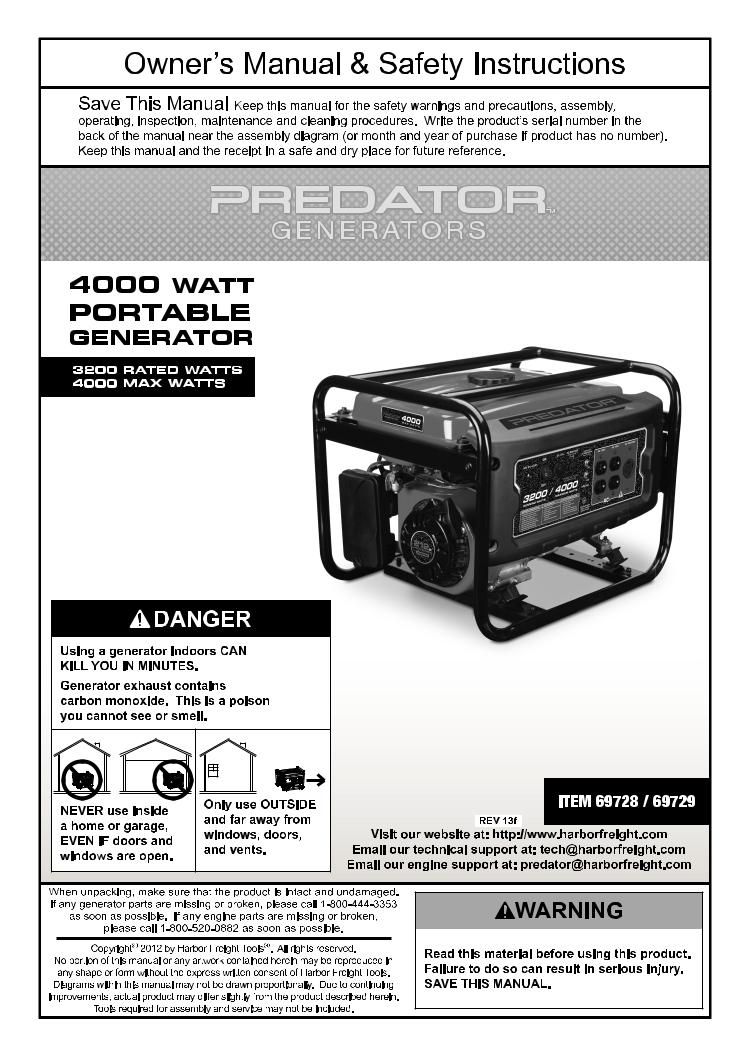

SAFETY
Table of Contents
.........................................................Safety |
2 |
..............................................Maintenance |
15 |
Setup .......................................................... |
6 |
Parts List and Diagram.............................. |
21 |
Specifications ............................................. |
6 |
Warranty .................................................... |
23 |
Operation.................................................... |
9 |
|
|
SETUP
WARNING SYMBOLS AND DEFINITIONS
This is the safety alert symbol. It is used to alert you to potential personal injury hazards. Obey all safety messages that follow this symbol to avoid possible injury or death.
Indicates a hazardous situation which, if not avoided, will result in death or serious injury.
Indicates a hazardous situation which, if not avoided, could result in death or serious injury.
Indicates a hazardous situation which, if not avoided, could result in minor or moderate injury.
Addresses practices not related to personal injury.
OPERATION
MAINTENANCE
IMPORTANT SAFETY INSTRUCTIONS
INSTRUCTIONS PERTAINING TO A RISK OF FIRE, ELECTRIC SHOCK, OR INJURY TO PERSONS
WARNING– When using tools, basic precautions should always be followed, including the following:
Set up Precautions
1.Gasoline fuel and fumes are flammable, and potentially explosive. Use proper fuel storage and handling procedures. Do not store fuel or other flammable materials nearby.
2.Have multiple ABC class fire extinguishers nearby.
3.Operation of this equipment may create sparks that can start fires around dry vegetation.
A spark arrestor may be required. The operator should contact local fire agencies for laws or regulations relating to fire prevention requirements.
4.Set up and use only on a flat, level, well-ventilated surface.
5.All connections and conduits from the Generator to the load must only be installed by trained and licensed electricians, and
in compliance with all relevant local, state, and federal electrical codes and standards, and other regulations where applicable.
6.Connections for standby power to a building electrical system must be made by a qualified electrician.The connection must isolate the generator power from utility power, and must comply with all applicable laws and electrical codes.
7.Wear ANSI-approved safety goggles, heavy-duty work gloves, and dust mask/respirator during set up.
Page 2 |
For Generator technical questions, please call 1-800-444-3353. |
Item 69728 / 69729 |
|
For Engine technical questions, please call 1-800-520-0882. |
|||
|
|
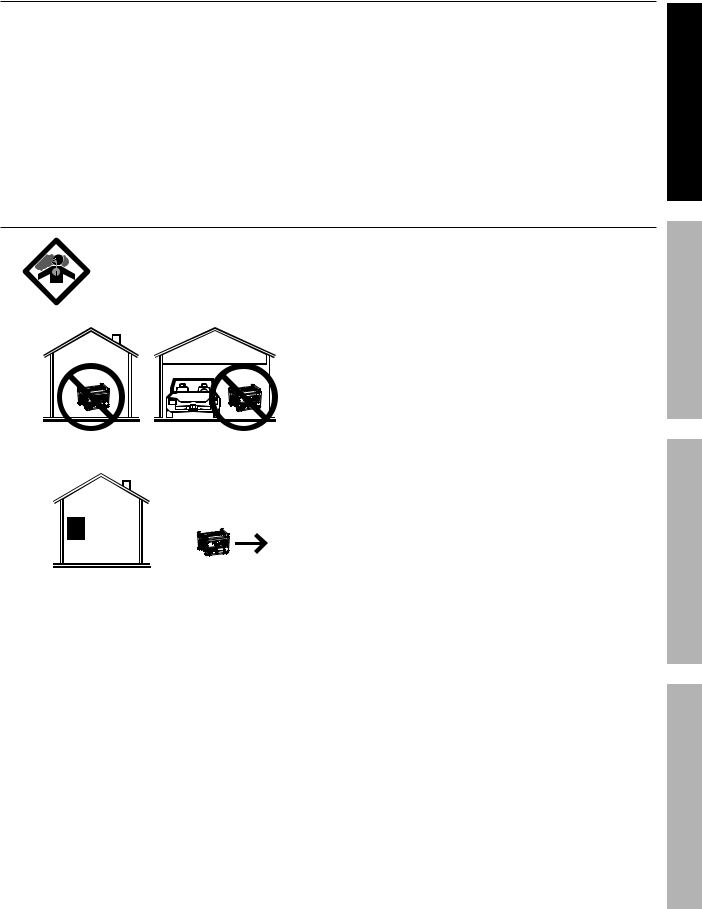
Set up Precautions (cont.)
8.Use only lubricants and fuel recommended in this manual.
9.Improper connections to a building electrical system can allow electrical current from the generator to backfeed into the utility lines. Such backfeed may electrocute utility company workers or others who contact the lines during a power outage, and the generator may explode, burn, or cause fires when utility power is restored. Consult the utility company and a qualified electrician if intending to use the generator for back up power.
10.Do not operate the Generator before grounding. The Generator must be earth-grounded
in accordance with all relevant electrical codes and standards before operation.
Operating Precautions
1.CARBON MONOXIDE HAZARD Using a generator indoors CAN KILL
YOU IN MINUTES.
Generator exhaust contains carbon monoxide. This is a poison you cannot see or smell.
NEVER use inside a home or garage, EVEN IF doors and windows are open.
Only use OUTSIDE and far away from windows, doors, and vents.
2.Never use a generator indoors, including in garages, basements, crawl spaces and sheds.
Opening doors and windows or using fans will NOT prevent carbon monoxide build up in the home.
3.When using generators, keep them outdoors and far away from open doors, windows, and vents to avoid toxic levels of carbon monoxide from building up indoors.
4.If you start to feel sick, dizzy, or weak while using a generator, get to fresh air right away.
The carbon monoxide from generators can quickly lead to full incapacitation and death.
5.Keep children away from the equipment, especially while it is operating.
6.Keep all spectators at least six feet from the Engine during operation.
7.Fire Hazard! Do not fill gas tank while engine is running. Do not operate if gasoline has been
spilled. Clean spilled gasoline before starting engine.
Do not operate near pilot light or open flame.
8.Do not touch engine during use. Let engine cool down before service or storage.
9.Never store fuel or other flammable materials near the engine.
10.If the plugged in product operates abnormally or unusually slow, immediately stop using the generator as a power sourceAlways. read and adhere to the instruction manual of the product to be powered, to make sure that it can be safely and efficiently powered by a portable generator.
11.Before connecting an appliance or power cord to the generator: Make sure that it is in good working orderFaulty. appliances or power cords can create a potential for electrical shock.
12.Do not exceed the maximum power rating of the generator.Make sure that the total electrical rating of the all of the tools or appliances plugged into the generator at the same time does not exceed that of the generator. Check that the startup surge will not be beyond the limit of the Generator. Power levels between rated and maximum
may be used for no more than 30 minutes.
13.Avoid substantially overloading which will trip the circuit breakerExceeding. the time limit for maximum power operation or slightly overloading the generator may not switch the circuit breaker or circuit protector OFF, but will shorten the service life of the generator.
14.Do not attempt to connect or disconnect load connections while standing in water, or on wet or soggy ground.
15.Do not touch electrically energized parts of the Generator and interconnecting cables or conductors with any part of the body, or with any non-insulated conductive object.
Item 69728 / 69729 |
For Generator technical questions, please call 1-800-444-3353. |
Page 3 |
|
For Engine technical questions, please call 1-800-520-0882. |
|||
|
|
SAFETY
SETUP
OPERATION
MAINTENANCE

SAFETY
SETUP
OPERATION
MAINTENANCE
Operating Precautions (cont.)
16.Connect the Generator only to a load or electrical system (120 volt or 240 volt) that is compatible with the electrical characteristics and rated capacities of the Generator.
17.Insulate all connections and disconnected wires.
18.Guard against electric shock.Prevent
body contact with grounded surfaces such as pipes, radiators, ranges, and refrigerators.
19.Only use a suitable means of transport and lifting devices with sufficient weight bearing capacity when transporting the generator.
20.Secure the Generator on transport vehicles to prevent the tool from rolling, slipping, and tilting.
21.Industrial applications must follow OSHA requirements.
22.Do not leave the Generator unattended when it is running. Turn off the Generator (and remove safety keys, if available) before leaving the work area.
23.The Generator engine can produce high noise levels.Prolonged exposure to noise levels above 85 dBA is hazardous to hearing. Always wear ear protection when operating or working around the gas engine while it is operating.
24.Wear ANSI-approved safety glasses and hearing protection during use.
25.People with pacemakers should consult their physician(s) before use.Electromagnetic
fields in close proximity to a heart pacemaker could cause pacemaker interference or pacemaker failure. Caution is necessary when near the engine’s magneto or recoil starter.
26.Use only accessories that are recommended by Harbor Freight Tools for your model.
Accessories that may be suitable for one piece of equipment may become hazardous when used on another piece of equipment.
27.Do not operate in explosive atmospheres, such as in the presence of flammable liquids, gases, or dust. Gasoline-powered engines may ignite the dust or fumes.
28.Keep grounded conductive objects, such as tools, away from exposed, live electrical parts and connections to avoid sparking or arcing.
These events could ignite fumes or vapors.
29.Stay alert, watch what you are doing and use common sense when operating this piece of equipment. Do not use this piece of equipment while tired or under the influence of drugs, alcohol or medication.
30.Dress properly.Do not wear loose clothing or jewelry. Keep hair, clothing and gloves away from moving parts. Loose clothes, jewelry or long hair can be caught in moving parts.
31.Parts, especially exhaust system components, get very hot during use. Stay clear of hot parts.
32.Do not cover the generator or its engine during operation.
33.Keep the generator, its engine, and surrounding area clean at all times.
34.Use the generator, accessories, etc., in accordance with these instructions and in the manner intended for the particular type of equipment, taking into account the working conditions and the work to be performed. Use
of the equipment for operations different from those intended could result in a hazardous situation.
35.Do not operate the generator with known leaks in the engine’s fuel system.
36.This product contains or, when used, produces a chemical known to the State of California to cause cancer and birth defects or other reproductive harm.(California Health & Safety Code § 25249.5, et seq.)
37.When spills of fuel or oil occur, they must be cleaned up immediately.Dispose of fluids and cleaning materials as per any local, state, or federal codes and regulations. Store oil rags in a bottom-ventilated, covered, metal container.
38.Keep hands and feet away from moving parts. Do not reach over or across generator while operating.
39.Before use, check for misalignment or binding of moving parts, breakage of parts, and any other condition that may affect the generator’s operation. If damaged, have the generator serviced before using.Many accidents are caused by poorly maintained equipment.
40.Use the correct generator for the application. Do not modify the generator or its engine, and do not use the generator for a purpose for which it is not intended.
Page 4 |
For Generator technical questions, please call 1-800-444-3353. |
Item 69728 / 69729 |
|
For Engine technical questions, please call 1-800-520-0882. |
|||
|
|
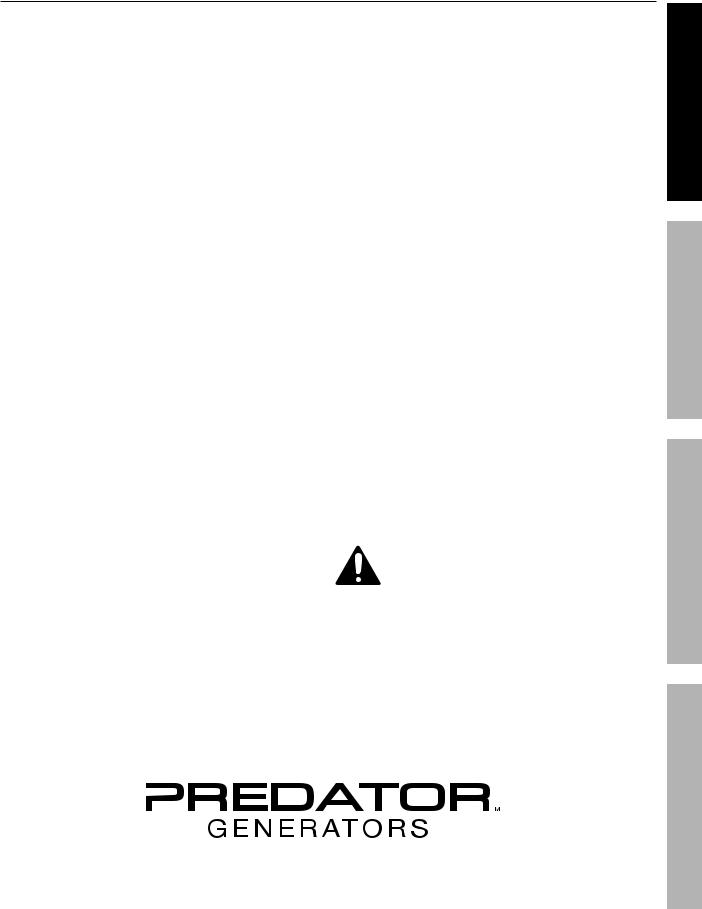
Service Precautions
1.Before service, maintenance, or cleaning:
a.Unplug all devices from the generator.
b.Turn the engine switch to its “OFF” position.
c.Allow the engine to completely cool.
d.Then, remove the spark plug cap from the spark plug.
2.Keep all safety guards in place and in proper working order.Safety guards include muffler, air cleaner, mechanical guards, and heat shields, among other guards.
7.Have the equipment serviced by a qualified repair person using only identical replacement parts. This will ensure that the safety of the equipment is maintained. Do not attempt any service or maintenance procedures not explained in this manual or any procedures that you are uncertain about your ability to perform safely or correctly.
8.Store equipment out of the reach of children.
9.Follow scheduled engine and equipment maintenance.
3.Keep all electrical equipment clean and dry. Replace any wiring where the insulation is cracked, cut, abraded, or otherwise degraded. Replace terminals that are worn, discolored, or corroded. Keep terminals clean and tight.
4.Do not alter or adjust any part of the equipment or its engine that is sealed by the manufacturer or distributor. Only a qualified service technician may adjust parts that may increase or decrease governed engine speed.
5.Wear ANSI-approved safety goggles, heavy-duty work gloves, and dust mask/respirator during service.
6.Maintain labels and nameplates on the equipment. These carry important
information. If unreadable or missing, contact Harbor Freight Tools for a replacement.
Refueling:
1.Do not smoke, or allow sparks, flames, or other sources of ignition around the equipment, especially when refuelling.
2.Do not refill the fuel tank while the engine is running or hot.
3.TO PREVENT FUEL LEAKAGE AND FIRE HAZARD,Do not overfill with fuel. Fill with fuel according to the Fuel Level information below the Specification chart for your model.
4.Do not fill fuel tank to the top. Leave a little room for the fuel to expand as needed.
5.Refuel in a well-ventilated area only.
6.Wipe up any spilled fuel and allow excess to evaporate before starting engine. To prevent FIRE, do not start the engine while the smell of fuel hangs in the air.
SAVE THESE INSTRUCTIONS.
SAFETY
SETUP
OPERATION
MAINTENANCE
Item 69728 / 69729 |
For Generator technical questions, please call 1-800-444-3353. |
Page 5 |
|
For Engine technical questions, please call 1-800-520-0882. |
|||
|
|

SAFETY
SETUP
OPERATION
MAINTENANCE
Functional Description
Specifications
|
Rated Output |
|
120/240V~, 60Hz |
|
|
|
3,200 Watts (4,000 max) |
||
|
|
|
||
Generator |
Phase |
|
Single |
|
|
|
Two 3-Prong, duplex NEMA #5-15 120V |
||
|
|
|
||
|
Electrical Receptacle |
One 4-Prong, NEMA #L14-30 twistlock 120V/240V |
||
|
|
|
One DC Outlet 12VDC |
|
|
Displacement |
|
212cc |
|
|
Engine Type |
|
Horizontal Single Cylinder 4 stroke OHV |
|
|
Cooling System |
|
Forced air cooled |
|
|
Fuel |
Type |
87+ octane unleaded gasoline |
|
Engine |
Capacity |
4 Gallons (15L) |
||
|
||||
|
Type SAE |
10W-30 above 32° F |
||
|
Engine Oil |
5W-30 at 32° F or below |
||
|
|
|||
|
|
Capacity |
.6 Quart (.6L) |
|
|
Run Time @ 50% load |
10 hr. |
||
|
Spark Plug |
|
Torch® F6TC or equivalent / 0.7-0.8mm gap |
|
|
Operational Volume |
|
70 dB |
|
|
Available accessories |
Wheel kit (sold separately) |
||
Item 69728 - The emission control system for this Generator’s Engine is warranted for standards set by the U.S. Environmental Protection Agency and by the California Air Resources Board (also known as CARB). For warranty information, refer to the last pages of this manual.
Item 69729 - The emission control system for this Generator’s Engine is warranted for standards set by the U.S. Environmental Protection Agency. For warranty information, refer to the last pages of this manual.
Components and Controls
DC Receptacle
|
DC Circuit Breaker |
|
Fuel Cap |
|
AC Circuit Breaker |
Fuel Valve |
|
Choke |
AC Receptacles |
|
Air Filter |
|
|
|
|
Frame |
|
|
|
|
|
|
Ground Terminal |
||
|
Starter |
Power Switch |
|
|
|
|
|
||
|
Handle |
|
|
|
|
|
Low Oil Indicator |
|
|
Page 6 |
For Generator technical questions, please call 1-800-444-3353. |
Item 69728 / 69729 |
||
For Engine technical questions, please call 1-800-520-0882. |
||||
|
|
|||
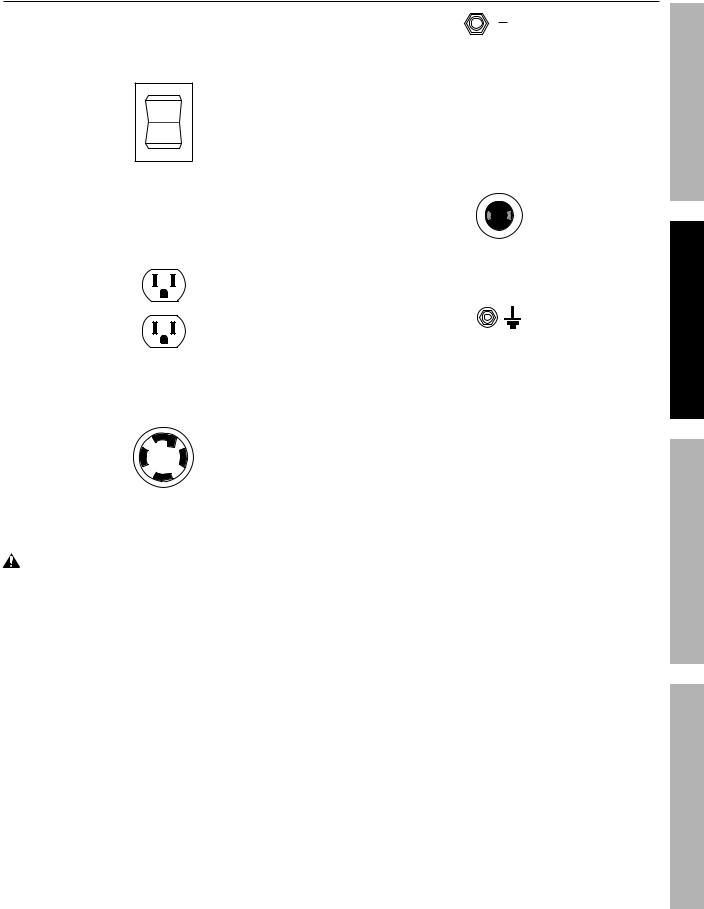
Components and Controls (cont.)
The following are descriptions of the controls on the power panel. Your generator has sockets to power your products with circuit breakers to protect the voltage flow.
I
O
1.Engine Switch: Used to start and stop the Engine.
2.AC Receptacles: The Generator contains several AC Receptacles to power tools and equipment.
a.3-Prong, duplex
120 volt AC Receptacle (NEMA #5-15)
b.4-Prong, twistlock
120/240 volt AC Receptacle (NEMA #L14-30)
WARNING! Connect tools and equipment only to the AC Receptacle that is compatible with the electrical characteristics and rated capacities of the tools and equipment being used.



 ON
ON



 OFF
OFF
3.Circuit Breakers: The circuit breaker protects the Generator from overloading. The rating of the breaker and the load it protects are marked near the breaker. Should any of the Circuit Breakers trip, the Generator will stop the electricity output. If this happens, unplug all loads from the Generator. Allow the Generator to cool down. Then, press the tripped Circuit Breaker, restart the Engine, and re-attach loads.
4.DC Outlet Receptacle:12 VDC outlet receptacle set provides a power source for 12 volt DC items.
5.Grounding Terminal:Prior to each use, set up the ground wire (not included) connection to the Grounding Terminal to properly ground the Generator. See Set up instructions
to properly ground the Generator.
SAFETY
SETUP
OPERATION
MAINTENANCE
Item 69728 / 69729 |
For Generator technical questions, please call 1-800-444-3353. |
Page 7 |
|
For Engine technical questions, please call 1-800-520-0882. |
|||
|
|
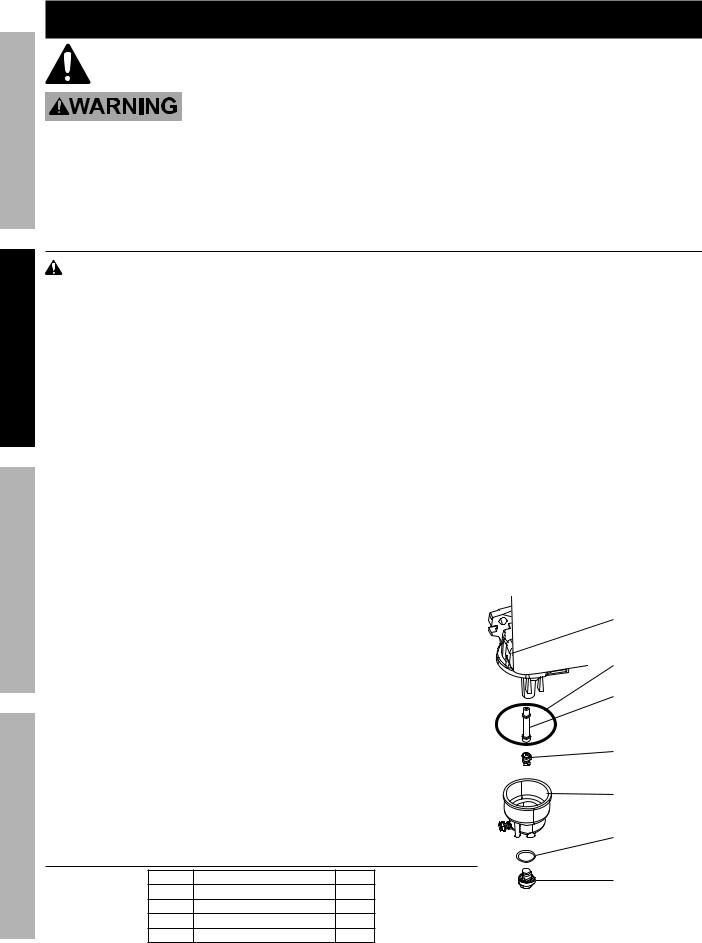
SAFETY
SETUP
OPERATION
MAINTENANCE
Initial Tool Set Up/Assembly
Read the ENTIRE IMPORTANT SAFETY INFORMATION section at the beginning of this manual including all text under subheadings therein before set up or use of this product.
TO PREVENT SERIOUS INJURY:
Operate only with proper spark arrestor installed.
Operation of this equipment may create sparks that can startesfiraround dry vegetation. A spark arrestor may be required. The operator should contact local fire agencies for laws or regulations relating to fire preventionrequirements.
High Altitude Operation Above 3000 feet
WARNING!TO PREVENT SERIOUS INJURY FROM FIRE:
Follow instructions in a well-ventilated area away from ignition sources.
If the engine is hot from use, shut the engine off and wait for it to cool before proceeding. Do not smoke. NOTICEWarranty void if necessary adjustments are not made for high altitude use.
At high altitudes, the engine’s carburetor, governor, and any other parts that control the fuel-air ratio will need to be adjusted by a qualified mechanic to allow efficient hightitude-al use and to prevent damage to the engine and any other devices used with this product. The fuel system on this engine may be influenced by operation at higher altitudes. Proper operation can be ensured by installing an altitude kit at altitudes higher than 3000 ft. above sea level. At elevations above 8000 ft, the engine may experience decreased performance, even with the proper main jet. Operating this engine without the proper altitude kit installed may increase the engine’s emissions and decrease fuel economy and performance. The kit should be installed by a qualified mechanic.
1.Turn off the engine.
2.Close the fuel valve.
3.Place a bowl under the fuel cup to catch any spilled fuel.
CAUTION!Carburetor bowl may have gas in it which will leak upon removing the bolt.
4.Unthread the bolt holding the fuel cup.
5.Remove the bolt, Bolt Seal, fuel cup, Fuel Cup Seal and Main Jet from the body of the carburetor assembly. A carburetor screwdriver (not included) is needed to remove and install the Main Jet.
Note: The mixing tube is held in place by the Main Jet and might fall out when it is removed. If it falls out, replace it in the same orientation before replacing the Main Jet.
6.Replace the Main Jet with the replacement Main Jet needed for your altitude range (part 1a or 2a).
Note:The Fuel Cup Seal and Bolt Seal may be damaged during removal and should be replaced with the new ones from the kit.
7.Replace the Fuel Cup Seal (4a), fuel cup, Bolt Seal (3a), and bolt. Tighten in place.
CAUTION:Do not cross thread bolt when tightening.
Finger tighten first and then use a wrench to make sure the bolt is properly threaded.
8.Wipe up any spilled fuel and allow excess to evaporate before starting engine. To prevent FIRE, do not start the engine while the smell of fuel hangs in the air.
Carburetor
Assembly
Fuel Cup Seal
Mixing Tube
(might remain inside carburetor)
Main Jet
Fuel Cup
Bolt Seal
High Altitude Kit Parts List - A
Part |
Description |
Qty |
1a |
Main Jet 3000-6000 ft. |
1 |
2a |
Main Jet 6000-8000 ft. |
1 |
3a |
Bolt Seal |
1 |
4a |
Fuel Cup Seal |
1 |
Page 8 |
For Generator technical questions, please call 1-800-444-3353. |
|
For Engine technical questions, please call 1-800-520-0882. |
||
|
Bolt
Item 69728 / 69729
